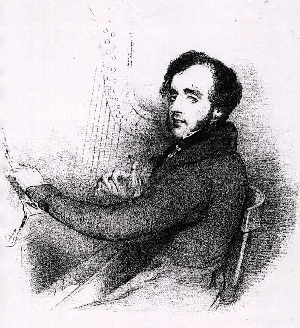MusicWeb International
Let us begin with a group of harpists. John Balser Chatterton was born at Portsmouth in 1805 and was thus unusually an English harpist (most of the famous British ones have hailed from Wales or Ireland). He became Professor of his instrument at the Royal Academy of Music in 1827, succeeding his teacher Bochsa, and Harpist to Queen Victoria in 1842. He wrote much music for harp especially arrangements of traditional airs of the British Isles - two of his more ambitious pieces were the Fantasias, Chords of Harmony and Peace or Recollections of the Crystal Palace and Bridal Chimes. His brother Frederick was Harpist to HRH the Duchess of Gloucester and played in Doncaster in January 1856 when he programmed several items by "Chatterton" which was presumably himself but it could have been his brother, viz Highland Ballads, Welsh Bardic Illustrations, Morceau Fantastique and Partant Pour Le Syrie. John Chatterton died in April 1871 and was succeeded as Harpist to the Queen by John Thomas. musicweb-international.com
BBC archive
The post of Official Harpist to HRH The Prince of Wales was reinstated in 2000. The Prince re-established the position of harpist to help celebrate and foster musical talent in Wales. The first player to be appointed to the re-established position was Catrin Finch, who was official harpist from 2000-04. She was succeeded by Jemima Phillips 2004-07 and recently Claire Jones 2007-09
Historically, previous postholders have included Welshman, John Thomas (1826-1913) who succeeded the Englishman, John Chatterton in 1871 as Royal harpist to Queen Victoria and continued as the King?s Harper to King Edward until his death in 1913.
Nansi Richards (1888-1976) ? student of John Thomas, was appointed Royal Harpist to The Prince of Wales at his investiture in 1911.
Some (conflicting?) data from Harp Music Shop
Dedication: John Balsir Chatterton was born in Norwich in 1805 and died in London in 1871. He studied harp with Bochsa and Labarre at the same time as Parish Alvars. The two probably met at some point between 1820 and 1825. In 1827 Chatterton obtained a position as harp teacher 'at the age of only 22' at the Royal Academy of Music. He held this position until 1850. In 1840 he became Queen Victoria's harpist. Chatterton's oeuvre is quite large, even if few of his melodies are original. In any case, his efforts to expand the harp repertoire deserve mention. In fact, he published many transcriptions for harp as well as several collections of traditional British airs.
